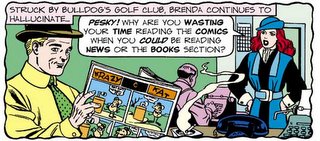Getting On-Line Is Getting Out of Line

[gary daily col. 35 September 29, 2002]
“For every reader who dies today, a viewer is born.”
-- Edward A. Morrow, past president of Association of American Publishers, 1995
In his review of the recently released movie, “fear dot com,” Stephen Holden, a New York Times film critic forewarns moviegoers, “a Web site on the Internet has acquired a malevolent intelligence that beams demonic energy into those who visit it and stimulates their worst nightmares.”
Now take a leap, ask: Is the malevolent and the demonic in the form of computer technology invading the libraries of America?
It’s not that every click of a computer mouse sends a pulse of dread and loss into the heart of my reading soul. But when I observe the growing banks of computers filling elementary, high school, university, and public libraries I do envision a future of thought and imagination simplified, cramped and straightened rather than liberated.
Are you convinced that time at a computer can substitute for time with books? Can you weigh and sort out the opportunity costs (the sacrifice made in selecting one product or service over another) entailed in passively sitting before a gray screen and clicking it into virtual life versus sitting down with a book and being actively immersed in live pages of print?
Easy answers to such questions may elude us. But we can step back and examine the allocation of assets--financial, human, and promotional--being expended on the systems and products of information retrieval, intellectual stimulation, and community programming provided by libraries. Libraries have served their various publics with this mix of services since early in the twentieth century.

Weighting the elements in this mix has never been an easy, straightforward kind of decision. For example, in Vigo County, Indiana, the old Emeline Fairbanks Library building (f. 1906), with its Greco-Roman classical lines and stained-glass ceiling dome, spoke to the public in hushed and reverent tones. The Corinthian columns and stained-glass icons said to all, enter this building and you enter a depository of the wisdom and history of humankind. A promotional library poster of the 1930s proclaimed: “The Wit and Wisdom of the Ages await you here.”
But before becoming too hushed and humbled, give your attention to Ethel Hughes. Once the Emeline Fairbanks head librarian, she writes in her “Rules and Regulations” in 1922: “In the case of popular fiction the librarian has found it impossible to buy enough copies to supply the temporary demand.” Her “practical and popular” solution: purchase extra rental copies of these ephemeral materials. (See Irene McDonough, History of the Public Library in Vigo County: 1816-1975.)
From this it's fair to surmise that many patrons might ascend grand marble steps and pass through granite columns in awe, gaze up at the ceiling icons with reverence, but they often skipped out the doors and whistled down the steps carrying copies of current best sellers, not the works of statesmen and philosophers tested by time. The role of the library in a community is as complex as the diversity and needs of its patron base. One size does not fit all.
Nor can one box.
However a computer might be configured, it cannot stand in for books. Libraries have lurched wildly toward computer technology in an uncritical response to the glow of sales brochures and gauzy theories spinning tales of universal access. The “just punch a button” fictions of computer databases as presented in movies and TV dramas reinforce these unrealistic and unrealizable visions.
Rushing toward turning libraries into computer centers, with books and reading increasingly becoming an afterthought, is not only expensive, it is a wave of novelty that ignores centuries of library traditions and strengths. Library schools may crown themselves with the self-congratulatory title “Information Science,” but the establishment of a library as a cultural and intellectual institution is not a science. The foundations on which libraries rest are humanistic in character.
When libraries overemphasize computer technology while allowing book collections and support for reading and readers to languish, they risk evolving into “wired” anemic shells. Information is flat; it fits well on a screen. The riches of context and meaning reside between the covers of the technology called books.
Lovers of books and libraries need to ask: Why have e-books failed so miserably as a commercial venture? What have we learned from the Microsoft and web designer studies on reading on screen which conclude that computer reading must be designed for short attention spans? Did anyone who bought an iMac back in 1999 ever really learn, as Apple Corporations’ ungrammatical advertising campaign promised, to “think different”? Have I ever read an entire book on a computer screen? Do I plan to do so soon? Ever? And most importantly: Is computer technology in libraries a tool or a goal?

The deeper “malevolent intelligence” and deflating “demonic energy” of the contemporary “fear dot com” library is to be found in how its focus is shifting away from books and reading. Computers can be “hacked,” but they just don’t hack it when it comes to what books and reading bring to individuals and the community.


0 Comments:
Post a Comment
<< Home